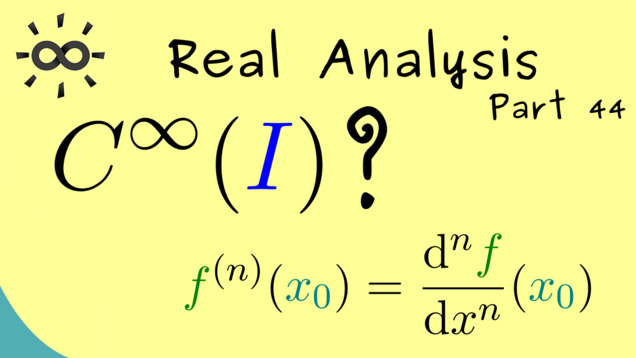
-
Title: Higher Derivatives
-
Series: Real Analysis
-
Chapter: Differentiable Functions
-
YouTube-Title: Real Analysis 44 | Higher Derivatives
-
Bright video: https://youtu.be/vyZ5ESoqsxw
-
Dark video: https://youtu.be/jJxvZXF8eZk
-
Quiz: Test your knowledge
-
Dark-PDF: Download PDF version of the dark video
-
Print-PDF: Download printable PDF version
-
Thumbnail (bright): Download PNG
-
Thumbnail (dark): Download PNG
-
Subtitle on GitHub: ra44_sub_eng.srt missing
-
Timestamps (n/a)
-
Subtitle in English (n/a)
-
Quiz Content
Q1: Let $f \colon \mathbb{R} \rightarrow \mathbb{R}$ be a function. What is the difference between ‘differentiable’ and ‘continuously differentiable’?
A1: There is no difference.
A2: A differentiable function is always a continuous differentiable function but not vice versa
A3: A continuous differentiable function is a differentiable function where $f^\prime$ is also continuous.
A4: A continuous differentiable function is a differentiable function where $f^\prime$ is also differentiable.
Q2: Let $f \colon \mathbb{R} \rightarrow \mathbb{R}$ be a two-times differentiable function. Is $f$ continuously differentiable?
A1: Yes!
A2: No!
A3: One cannot say it.
Q3: Let $f \colon \mathbb{R} \rightarrow \mathbb{R}$ be given by $f(x) = x^5$. Which claim is not correct?
A1: $f$ is two-times differentiable.
A2: $f$ is 5-times differentiable.
A3: $f$ is 6-times differentiable.
A4: $f$ is $\infty$-times differentiable.
A5: $f$ has a local maximum at $x_0 = 0$.
Q4: Let $f \colon \mathbb{R} \rightarrow \mathbb{R}$ be given by $f(x) = (x-1)^2$. Which claim is correct?
A1: $f^{\prime \prime}(0) > 0$ implies there is a local minimum at $x_0 = 0$.
A2: $f^{\prime \prime}(1) > 0$ implies there is a local maximum at $x_0 = 1$.
A3: $f^\prime(1) = 0$ and $f^{\prime \prime}(1) > 0$ imply there is a local minimum at $x_0 = 1$.
A4: $f^\prime(1) = 0$ and $f^{\prime \prime}(1) < 0$ imply there is a local minimum at $x_0 = 1$.
-
Last update: 2024-10